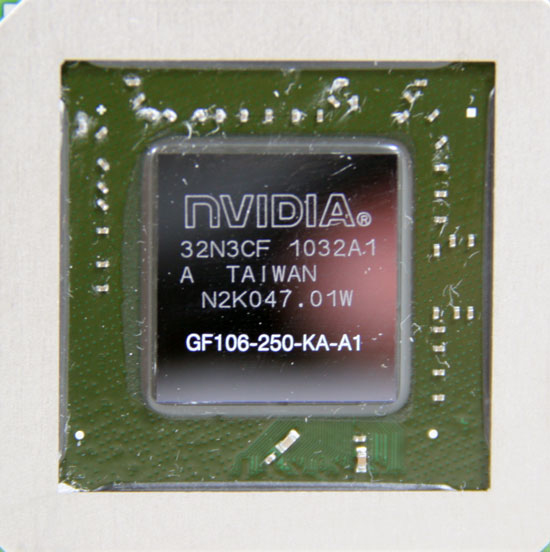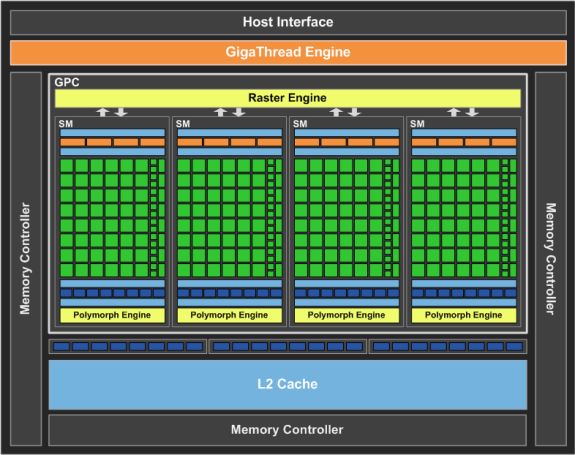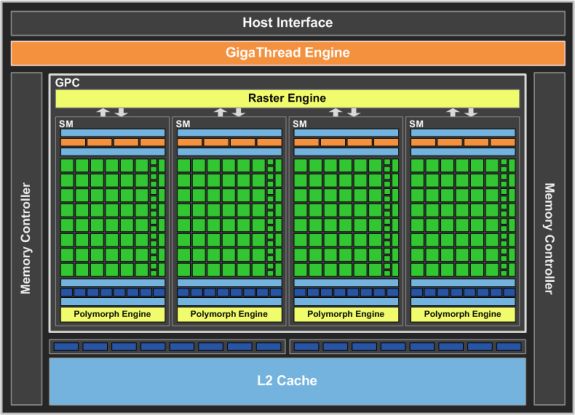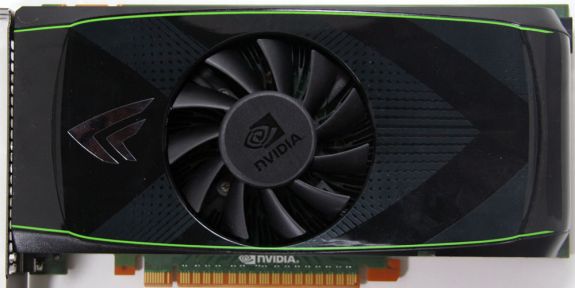NVIDIA’s GeForce GTS 450: Pushing Fermi In To The Mainstream
by Ryan Smith on September 13, 2010 12:02 AM EST- Posted in
- NVIDIA
- Fermi
- GeForce GTS 450
- GF106
- GPUs
After the drawn out launch of GF100 and the GTX 400 series earlier this year, NVIDIA has been firing on all cylinders when it comes to the launch of the rest of the Fermi family. In July we saw the launch of the GF104 GPU and the GTX 460 it powers, providing a surprising tweak to the Fermi architecture on what should have been a simple waterfall part, and in the process trampling AMD’s Radeon HD 5830 at the $200 price point. For the first time in over a year we saw an NVIDIA product come out that was hyper-competitive on performance and pricing, the kind of competition we sorely miss.
Now 2 months after that launch we’re going to find out if lightning strikes twice. Today NVIDIA is launching the next desktop video card in the 400 series: GTS 450 Powering it is their new Fermi family GPU – GF106 – the next in the line of successively smaller Fermi GPUs for cheaper products. Targeted directly against AMD’s Radeon HD 5700 series, does it have what it takes to dethrone AMD's mainstream lineup?
| GTX 480 | GTX 460 768MB | GTX 285 | GTS 450 | GTS 250 | |
| Stream Processors | 480 | 336 | 240 | 192 | 128 |
| Texture Address / Filtering | 60/60 | 56/56 | 80 / 80 | 32/32 | 64/64 |
| ROPs | 48 | 24 | 32 | 16 | 16 |
| Core Clock | 700MHz | 675MHz | 648MHz | 783MHz | 738MHz |
| Shader Clock | 1401MHz | 1350MHz | 1476MHz | 1566MHz | 1836MHz |
| Memory Clock | 924MHz (3696MHz data rate) GDDR5 | 900MHz (3.6GHz data rate) GDDR5 | 1242MHz (2484MHz data rate) GDDR3 | 902MHz (3.608GHz data rate) GDDR5 | 1100MHz (2.2GHz data rate) GDDR3 |
| Memory Bus Width | 384-bit | 192-bit | 512-bit | 128-bit | 256-bit |
| Frame Buffer | 1.5GB | 768MB | 1GB | 1GB | 1GB |
| FP64 | 1/8 FP32 | 1/12 FP32 | 1/12 FP32 | 1/12 FP32 | N/A |
| Transistor Count | 3B | 1.95B | 1.4B | 1.17B | 754M |
| Manufacturing Process | TSMC 40nm | TSMC 40nm | TSMC 55nm | TSMC 40nm | TSMC 55nm |
| Price Point | $499 | $169 | N/A | $129 | $99 |
At the heart of the GTS 450 is the GF106 GPU, which is probably not one of NVIDIA’s best-kept secrets. Traditionally GPUs launch in desktop products first before getting the mobile treatment, but in the case of the 400 series it’s a bit of the inverse. GF100 and GF104 launched in desktop products first, but GF106 and GF108 were launched in a somewhat quiet manner earlier this month when NVIDIA unveiled their mobile 400 series lineup. So GF106 itself is not being unveiled today, but we do have more concrete details about it that weren’t available for the mobile launch.
If you recall GF104, it set itself up nicely to be cut-down for GF106. With 384 CUDA cores spread over 2 GPCs and 4 sets of ROPs & memory controllers, half of a GF104 and what presumably would be a GF106 was easy to see. Instead what we’re getting is a bit of a curveball, as GF106 is a bit more than half of a GF104.
Fundamentally it’s GF104-derrived, sporting the 48 CUDA cores per SM design that GF104 pioneered. But while NVIDIA did end up removing 1 of the 2 GPCs (and by extension, half the CUDA cores), they didn’t halve the ROPs and memory controllers while they were at it. As a result GF106 is a bit more than we bargained for, entering the world as a 192 CUDA core part but with 3 sets of memory controllers and ROPs, for a combined total of a 192bit memory bus, 384KB of L2 cache, and 24 ROPs. Internally this is organized as a 1 GPC part containing 4 SMs, resulting in GF106 having 1 Raster Engine and 4 Polymorph engines; meanwhile the contents of each SM remains unchanged from GF104, so for each SM there are 48 CUDA cores and 4 texture units (for a total of 16 texture units in GF106) along with its Polymorph Engine.
But like GF104, GF106 won’t immediately be seen in its full form. NVIDIA is launching their desktop GF106 cards with 1 of the 3 sets of memory controller/ROP pairs disabled. As a result GTS 450 as we know it today is going to be a 192 CUDA core part, but using a 128bit memory bus with 256KB of L2 cache and 16 ROPs. For the time being the only product that’s been announced that will use a full GF106 GPU is the GeForce GT 460M, which will be available in a 192bit configuration with all 192 CUDA cores enabled.
At 1.17 billion transistors GF106 is not particularly big; NVIDIA won’t give us the die size, but a really rough estimate on our part is 240mm2(15mm x 16mm). With that in mind, we hear that 40nm yields at TSMC are caught up with 55nm yields, so we’re not entirely sure why NVIDIA is launching only harvested parts today. At first glance it seems like they could launch a 2nd, fully-equipped card for a higher price and profit margin, but admittedly we don’t have all the facts. The biggest question of course is whether enabling the extra memory controller and ROPs provides a material benefit – if GF106 is shader limited at these clockspeeds, then perhaps it isn’t worth it. Hopefully one day we’ll find out if this is the case.

In any case, the star of the show today is GTS 450, the newest member of the GeForce family and intended for gaming at resolutions around 1680x1050. It’s clocked at 783MHz for the core, 1566MHz for the shaders, and 902MHz (3.6GHz effective) for its GDDR5 RAM. Currently it’s only being offered in a 1GB configuration; however we wouldn’t be shocked to see a 512MB part further down the line at even more budget-oriented prices. NVIDIA is launching the card at $129 and will be using it to replace the GTS 250, the last and most powerful card based on NVIDIA’s long-lived workhorse, G92. This makes GF106 the de-facto successor to G92, a very tough act to follow.
NVIDIA puts the TDP for a reference GTS 450 at 106W, though as NVIDIA likes to note this is a “real world” number and FurMark can exceed this. NVIDIA does not provide an idle TDP for GTS 450, however as you’ll see in our tests it’s clearly quite low. Like the GTX 460, NVIDIA is heavily pushing the overclockability of GTS 450, and as a result a large number of factory-overclocked cards will be launching alongside reference-clocked cards. This pushes the TDP further out but it improves performance a great deal – the fastest of the vendor cards we’re looking at today is 930MHz, a 19% factory overclock. These cards will of course command a higher price, although we hear some of the lesser overclocked cards may hit the same $129 price as the reference-clocked cards.
Finally, NVIDIA is once again repricing the 400 series lineup with this launch. The MSRP of the GTX 470 and GTX 465 are down to $300 and $230 respectively. Meanwhile GTX 460 is also getting a price drop – the 1GB version drops by $10 to $220 while the 768MB version takes a much bigger price drop of $30 to $170. At $200 the 768MB GTX 460 was already a good deal, but as we noted in our on review for $30 more it made much more sense to grab the 1GB card with its wider memory bus and additional ROPs. As a consequence NVIDIA has driven a larger price gap between the two cards so that the 768MB version isn’t passed up in favor of the 1GB version as often.
Finally we have the GTS 450, which is launching at $130. NVIDIA was clearly going for a price between the Radeon HD 5770 and 5750, however AMD apparently expected this and has worked with partners to nudge prices down – the cheapest 5770s can be found for $130 after rebate. If these prices hold then the GTS 450 is basically in lock-step with the 5770, but we’re only seeing a few 5770s at this price so it may prove to be a temporary launch day counter-attack. In any case AMD is definitely under some pricing pressure thanks to the GTX 460 price drop – the GTX 460 is significantly faster than the 5770, so they can’t realistically charge more than $150 for it and leaving them few options besides bringing prices down and putting pressure on the GTS 450.
| September 2010 Video Card MSRPs | ||
| NVIDIA | Price | AMD |
| $700 | Radeon HD 5970 | |
| $500 | ||
|
|
$360 | Radeon HD 5870 |
| $300 | ||
|
|
$270 | Radeon HD 5850 |
| $230 | ||
| $220 | ||
| $170 | Radeon HD 5830 | |
| $130 | Radeon HD 5770 | |













66 Comments
View All Comments
Ryan Smith - Monday, September 13, 2010 - link
If I had my way, we'd have every card known to man on our charts. But if I had my way, days would be 50 hours long to accommodate all of that testing...In any case not having a GTS 250 is not an oversight on our part - we simply do not have a GTS 250 to test with.
Stuka87 - Monday, September 13, 2010 - link
So it seems to me like the 450 is trying to match performance with the now year old 5770. I really think nVidia should have one upped the competition, like they did with the 460 release.I just can't see this card getting the life that nVidia needs to get out of it. AMD will do a refresh long before nVidia does, which will ultimately mean the 450 will have a very short life in comparison to the 5770.
HangFire - Monday, September 13, 2010 - link
This comment is right on the mark, and part of a disturbing trend I see with new video card generations in general and Nvidia in particular. With each new generation we are getting the same performance, more or less, at the same price points, the only difference is a newer Direct X level, lower power, or less noise, or a new video connector, etc.If all you care about is getting a certain FPS in a few games on one monitor with a certain level of AA and eye candy, the older generation cards would often be a better choice, if they were only available. Unlike in previous generations, which seemed to stay in production forever even when obsolete, the best values either go away (like the 4770 or GTX 275), get recycled at the same or higher price point (8800/9800), or get replaced by similar performance at that price point (GTS 450 vs 250).
The end result is that for a give price point, you are not buying any more Frames per Second then you were 2 years ago- unless you paid too much and made a really bad choice 2 years ago.
While at first I was thrilled to see so many older cards in this review, the GTS 250 is conspicuously absent, perhaps because it is rather embarrassing to see what little new the 450 has to offer in terms of price/performance. The 450 is not yet on Bench either, though I hope that will be remedied soon.
So, congratulations Nvidia, you now have a more complete DirectX 11 lineup, but you've offered me nothing in price/performance to make me want to replace any of my DirectX 10 cards.
just4U - Monday, September 13, 2010 - link
I disagree. Annand put up numbers for the 4850 which has always pretty much walked allover the GTX250 (9800GTX 8800GTX etc) Looking at the graphs the 450 is somewhat faster so including the 250 benchmarks is not neccessary.Also, Both Ati and Nvidia seem to be in a holding pattern as far as performance goes with their current lineups. People upgrading from the latest and greatest from the last generation of video cards won't notice huge gains performance wise. What they will notice (depending on the card) is lower temperatures, less power consumption, and ofcourse more features.
Those upgrading from cards 2+ years old or value oriented cards from the last generation are likely to see the most gains overall with these new ones. The rest of us get a sideways upgrade at best. Atleast thats my opinion anyway.
geniekid - Monday, September 13, 2010 - link
I must also disagree, respectfully. A couple of the benchmarks here show that for less than half the price I paid for my top-of-the-line factory OCed 9800GTX several years ago, I can get about the same or slightly better performance. This shows me that progress is being made - or, at the very least, that price/performance is improving over time.HangFire - Monday, September 13, 2010 - link
Wow, thanks for the respect in the disagreement! But then, this is AT not Tom's.Speaking of Tom's, I just read their GTS450 review, and their statement after the DX9-10 benchmarks (CoD:MW2 and Crysis) mirrors mine vis-a-vis the GTS 250- "Naturally, numbers like this don’t compel you to upgrade." While another site quoted 20-25% better performance, Tom's had the 250 faster than the 450.
I would expect a three generation old top-of-the-line card to have poor value compared to a mainstream card of today. (I say three because a 9800 GTX OC is essentially an 8800 Ultra). Nvidia complicates the issue with generational recycling and the missing GTX 3xx DirectX 10.1 cards that never existed. I'm trying to compare like-to-like, that is mainstream cards in the $140 to $150 range (price at introduction).
If you look at the incremental performance differences of the mid-stream cards 8800GT->9800GT->GTS 250->GTS 450, anyone that actually bought each of these cards for $130->$150 expecting a big generational performance boost with each jump was sorely disappointed. On the AMD side things are a little better, but the mainstream level 4xxx to 5xxx jump was more about power and Eyefinity than performance. (Of course their top-end cards made big jumps, at big $$$).
The new GTS 450 is launched at the same price point the GTS 250 had, and offers very similar performance. Of course, the 250 dropped in price like a stone, because it had to, and the 450 may have some adjustments ahead of it. But let's say it was 25% faster across the board, is it compelling? The 7800GT to 8800GT upgrade, now that was compelling.
just4U - Monday, September 13, 2010 - link
You have to remember something though.. the 8800 line was a new standard by which all cards are/were measured by. Like the Radeon 9700/800 it takes years to move past it... We do not see those crazy bumps in performance and features happen often afterall.IceDread - Monday, September 13, 2010 - link
"The GTX 460 was a card that made the comparable AMD card obsolete and brought significantly improved performance to the $200 market. NVIDIA had a card built to hit one of AMD’s weak spots, and it struck beautifully. "A news site should strive towards being unbiased but anandtech sure does not do that.
just4U - Monday, September 13, 2010 - link
Have you had the oportunity to use the 460? Or the 5830/50 that it competes against? Anandtech hit the nail on the head with that statement and it's not based upon Ati/Nvidia bias. Simply put it's one of the best buys on the market right now and with all of Nvidia's misteps it's surprising to see them come out with a card that is so hard to pick fault with.heflys - Monday, September 13, 2010 - link
Yeah, the GTX 460 1gb made the 5830 obsolete, but the 768mb version sure didn't. And the 5850 has started to come down in price, and you can now pick it up for $259 after rebate.